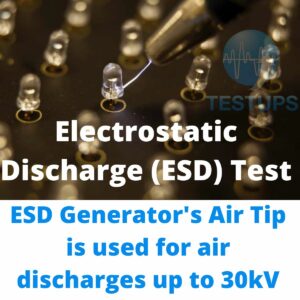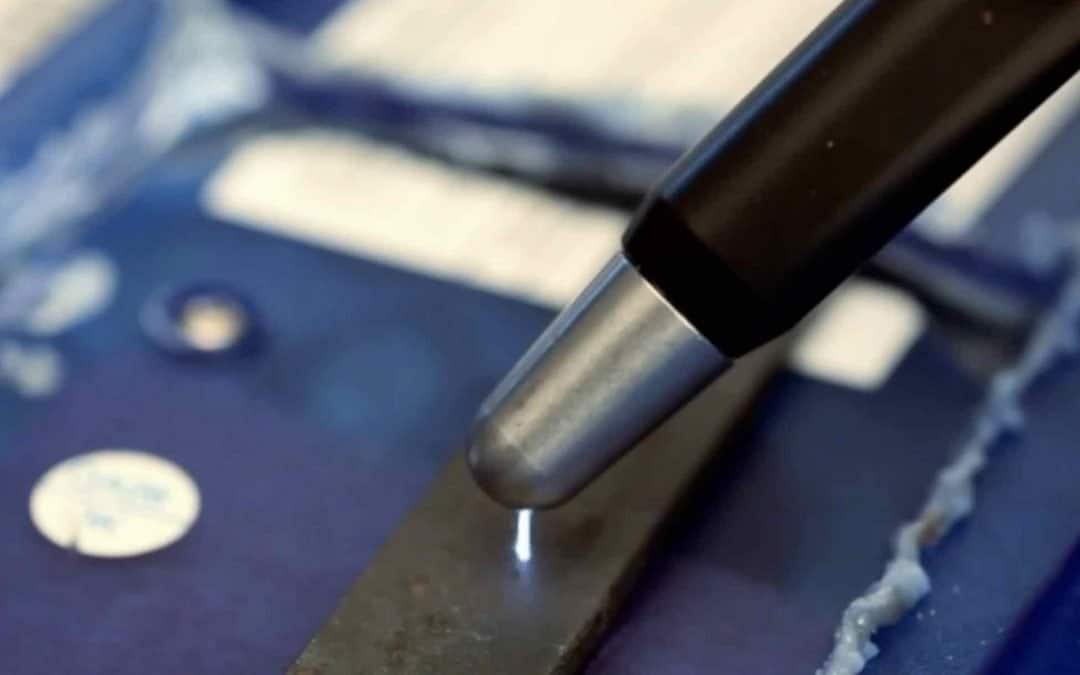IEC, on IEC 61000-4-2 standard, defines Electrostatic Discharge (ESD) as ”a transfer of electric charge between bodies of different electrostatic potential in proximity or through direct contact.”
How electrical and electronic equipments are subjected to electrostatic discarges?
ESD test standards are establishing a common and reproducible basis for evaluating the performance of electrical and electronic equipment when subjected to electrostatic discharges.
Electrostatic Discharge (ESD) testing is one of the Electromagnetic Compatibility (EMC) tests which are applied to electrical products or components. ESD testing is categorised as an immunity testing which is one of the EMC testing types. ESD testing is performed according to relevant product standard and ESD standard. ESD test standards depend on the product and its field of use.
Which testing instrument is used during ESD testing?
Electrostatic Discharge testing is performed by ESD generators or simulators. They can be named as guns since their shape is like a gun. ESD guns have different versions according to their maximum voltage levels like 15kV, 16kV, 30kV or more.
Which standards are applied for ESD testing?
There are many product standards referring ESD standards. Before ESD testing, the features of the product or EUT has to be checked and correct standards have to be chosen. Most of the commercial final products are under the scope of IEC 61000-4-2 standard. For automotive, ISO 10605 which describes test procedures for evaluating both electronic modules on the bench and complete vehicles, is used. ISO 10605 applies to all types of road vehicles regardless of the propulsion system (e.g. spark-ignition engine, diesel engine, electric motor). For products used in avionics, mostly used standard is RTCA DO-160 and its Section 25 defines ESD testing requirements.
ANSI/ESDA/JEDEC JS-001 standard establishes the procedure for testing, evaluating, and classifying components and microcircuits according to their susceptibility (sensitivity) to damage or degradation by exposure to a defined human body model (HBM) electrostatic discharge (ESD).
ANSI/ESDA/JEDEC JS-002 standard establishes the procedure for testing, evaluating, and classifying devices and microcircuits according to their susceptibility (sensitivity) to damage or degradation by exposure to a defined field-induced charged device model (CDM) electrostatic discharge (ESD). All packaged semiconductor devices, thin film circuits, surface acoustic wave (SAW) devices, opto-electronic devices, hybrid integrated circuits (HICs), and multi-chip modules (MCMs) containing any of these devices are to be evaluated according to this standard. To perform the tests, the devices must be assembled into a package similar to that expected in the final application.
There are various standards related to ESD testing. Learn more about ESD Testing Standards.
Definitions
In order to understand the terms of each standard, you have to check definitions of the standards. Check below definitions given on ISO 10605:2008 :
Air Discharge
test method characterized by bringing the test generator electrode close to the device under test (DUT); the discharge is by arcing on the DUT
Contact Discharge
test method characterized by contact of the test generator electrode with the DUT, where discharge is initiated by the generator discharge switch
Device Under Test (DUT)
single component or combination of components as defined to be tested
Direct Discharge
discharge directly on the DUT
ESD generator
instrument that simulates the human ESD model
Ground Reference Plane (GRP)
flat conductive surface whose potential is used as a common reference (Where applicable, it is advisable that the test voltage of the DUT and the operator ground also be referenced to the ground plane.)
Holding Time
interval of time within which the decrease of the test voltage due to leakage, prior to the discharge, is 10 %
Horizontal Coupling Plane (HCP)
metal plane oriented in horizontal direction, to which discharges are applied to simulate electrostatic discharge to objects adjacent to the DUT
Human ESD model
network of passive elements and voltage that characterizes a charged person as a source of an electrostatic discharge for automotive conditions
Indirect Discharge
discharge on a coupling plane near the DUT (Discharge current produces a transient field that might affect the DUT. Indirect discharge simulates discharge by a human being on items near the DUT.)
Surface
uninterrupted housing area, gap or opening
ESD Test Levels
Each ESD test standard defines ESD test levels to be applied to the EUT. IEC 61000-4-2 lists test levels as follows:
| Level | Contact discharge Test Voltage (kV) |
Air discharge Test Voltage (kV) |
|---|---|---|
| 1 | 2 kV | 2 kV |
| 2 | 4 kV | 4 kV |
| 3 | 6 kV | 8 kV |
| 4 | 8 kV | 15 kV |
| X | special | special |
The level X is an open level to be negotiated between the manufacturer and the purchaser or defined by the product committee.
The EUT shall be tested against the applicable test levels for its installation environment or environment of usage. Since IEC 61000-4-2 is a test standard and not a product standard, you have to check ESD test levels from applicable product standard. For instance, for medical devices, IEC/EN 60601-1-2 standard defines test levels as -/+2kV, -/+4kV and -/+8kV for air discharges and -/+2kV, -/+4kV and -/+6kV for contact discharges. IEC/EN 60601-1-2 defines ESD test levels and refers to IEC 61000-4-2 how to perform ESD testing.
Other ESD test standards, like ISO 10605 which is based in part on IEC 61000-4-2 and describes automotive-specific requirements, may define test levels higher than the levels shown on the table above. Thus, defining your product standard will make it easy to define ESD test levels for your product. ESD test levels can go up to 30 kV and these levels can be applied with the ESD generators which are able to generate 30 kV.

ESD Generator Parameters
IEC 61000-4-2 defines general ESD generator parameters as follows. These parameters can be updated if there is an update on IEC 61000-4-2.
| Voltage range contact discharge mode | at least 1 – 8 kV |
| Voltage range air discharge mode | at least 2 – 15 kV |
| Output voltage accuracy | equals or less than 5% |
| Output polarity | positive and negative |
| Rise time of short circuit current in contact discharge mode (10% to 90%) | 0.7 – 1 ns |
| Holding time | at least 5 sec. |
| Typical storage capacitance | 150 pF |
| Typical discharge resistance | 330 ohm |
IEC 61000-4-2 is noted that when an ESD generator is supplied from an external supply source, AC or DC, or controlled by a separate unit and this cable is not combined with the ESD generator return current cable, unintended current may flow through this cable.
Each ESD standard defines the parameters of the simulator or generator that will be used during ESD testing.
How to perform ESD testing?
ESD testing is one of the easiest EMC tests to perform since the test setup and equipments are simpler when compared to other EMC tests.
ESD tests are performed either for design validation or product certification. During ESD testing, Equipment Under Test (EUT) is tested with the items shown below
ESD Generator / Simulator / Gun
ESD Test Table
Horizontal Coupling Plane (HCP)
Vertical Coupling Plane (VCP)
Appropriate resistor and grounding
Each item is chosen according to standard applied. ESD test setups are prepared according to applied standard. If you would like to perform ESD tests according to IEC 61000-4-2, you have to get this standard and check it before starting testing. When you prepare the test setup (making necessary connections of ESD generator, test table, ground planes, grounding) ESD test expert (technician or engineer) applies the ESD signals to the EUT and checks the performance of it. Each ESD signal is generated by ESD simulator or gun is counted and recorded for reporting. If the EUT passes applied ESD test standard, photo of test setups, measurement results and records are documented as a test report.
ISO 10605 ESD Test Setup Requirements
Do you need ESD testing service or ESD gun for your laboratory?
We offer
ESD testing services (pre-compliance to full-compliance)
ESD test guns/simulators/generators (standard compliant)


Recent Comments